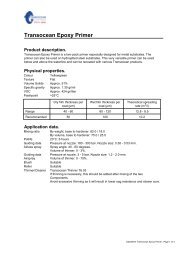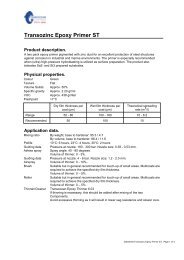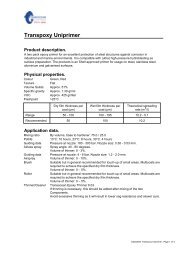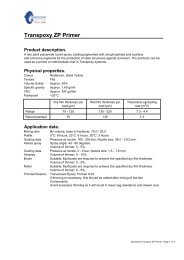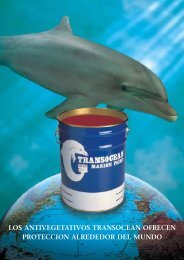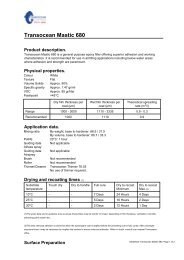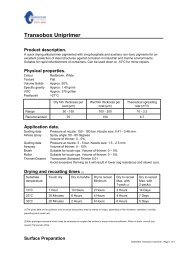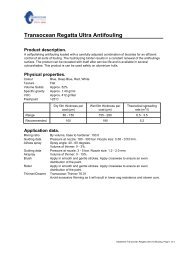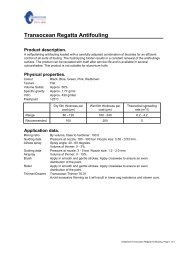Product Data Sheet Transpoxy MIO Primer 164 - Transocean Coatings
Product Data Sheet Transpoxy MIO Primer 164 - Transocean Coatings
Product Data Sheet Transpoxy MIO Primer 164 - Transocean Coatings
You also want an ePaper? Increase the reach of your titles
YUMPU automatically turns print PDFs into web optimized ePapers that Google loves.
Drying and recoating times (1)SubstratetemperatureTouch dry Dry to handle Full cure Dry to recoatMinimumDry to recoatMax.(2)10°C 12 Hours 24 Hours 14 Days 24 Hours Indefinite23°C 6 Hours 12 Hours 7 Days 12 Hours Indefinite30°C 4 Hours 10 Hours 4 Days 8 Hours Indefinite(1)The given data are for guidance only as actual drying times may be shorter or longer, depending on film thickness, ventilation, humidity,preceding paint system etc.(2)The best intercoat adhesion is achieved when the subsequent coat is applied before the preceding coat is fully cured. After prolongedexposure times it may be necessary to roughen the surface to ensure intercoat adhesion. When in doubt, consult your nearest <strong>Transocean</strong>office.Surface PreparationSteel - Blast CleaningAll surfaces should be clean, dry and free from contamination. Surfaces should be treated inaccordance with ISO 8504:2000.All edges shall be ground to a minimum radius of 2 mm. Remove weld spatter and smooth weldseams by using disc grinders, chipping hammers or other suitable power tools. Sharp edges, weldseams, corners and other areas that are likely to receive less dry film thickness than specified,should be stripe coated.The surfaces shall be blast-cleaned to min. Sa 2½ (ISO 8501-1:2007). The surface profile and theanchor pattern shall be between 40 µm and 70 µm.The abrasives shall be free from oil, grease, moisture, chloride contamination etc.Stainless SteelAll surfaces should be clean, dry and free from contamination. Surfaces should be treated inaccordance with ISO 8504:2000.Blast cleaning shall be carried out by smooth sweep blasting, using a fine non-iron containingabrasive (e.g. aluminium oxide). The abrasives shall be free from oil, grease, moisture, chloridecontamination etc.Surface roughness shall be in the range of 20 µm to 30 µm.Minor repair / Touch-upAll surfaces should be clean, dry and free from contamination. Surfaces should be treated inaccordance with ISO 8504:2000.Any corroded areas should be prepared by power-tool cleaning or water jetting.Power-tool cleaning to min. St 2, preferably St 3 (ISO 8501-1:2007). Care shall be taken to ensurethat power-tool cleaning does not polish the steel surface. If the surface being prepared liesadjacent to a coated surface, the power tool cleaning shall overlap the coated surface by at least25 mm and the coated surface shall be feathered.Water jetting in accordance to ISO 8591-4: 2006 to a cleanliness of Wa 2 or better for atmosphericexposure. Acceptable flash rust degree is M (medium) but degree L (light) is preferred.A water pressure of at least of 1000 bar (approx. 15.000 psi) is recommended.Contact your local <strong>Transocean</strong> office for more information.<strong>Data</strong>sheet <strong>Transpoxy</strong> <strong>MIO</strong> <strong>Primer</strong> <strong>164</strong>, Page 2 of 4.



